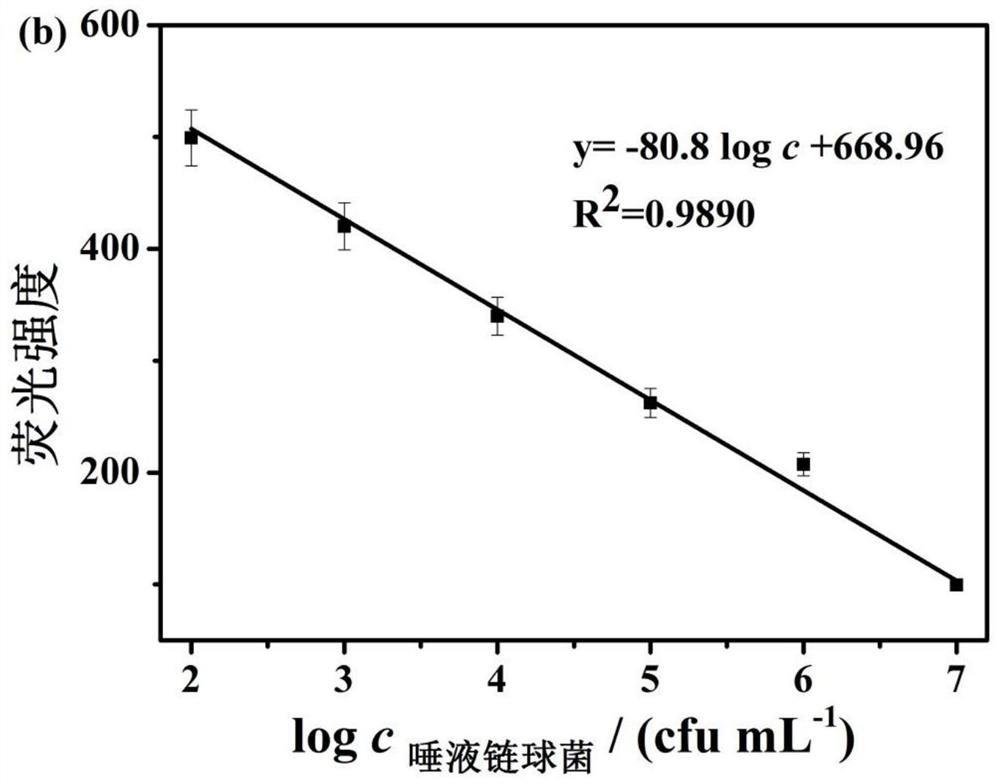Preparation method and application of silicon carbide@bsa-antimicrobial peptide nanoprobe
A nano-probe and silicon carbide technology, which is applied in the field of forensic science, can solve the problems of complex operation methods, long reaction time, and complicated forensic saliva identification, and achieve the effect of rapid quantitative detection, high sensitivity, and simple preparation
- Summary
- Abstract
- Description
- Claims
- Application Information
AI Technical Summary
Problems solved by technology
Method used
Image
Examples
Embodiment 1
[0040] A fluorescent bacterial sensor based on silicon carbide @BSA-antimicrobial peptide nanoprobe and its application in forensic saliva identification in this embodiment are carried out according to the following steps:
[0041] (1) Preparation of silicon carbide@BSA nano: Add 60mg of silicon carbide powder to 30ml of distilled water, adjust the pH to 9 with ammonia water; add 60mg of BSA to the above silicon carbide solution, and add the mixture to 50ml of poly Tetrafluoroethylene reaction kettle, heated to 140°C, reacted for 650 minutes to obtain a cloudy liquid, dialyzed with a dialysis bag for 3 days, and filtered with a 0.22 μm microporous membrane to obtain a purified silicon carbide @BSA-antimicrobial peptide nanoprobe;
[0042] (2) Preparation of silicon carbide@BSA-antimicrobial peptide nanoprobe-antimicrobial peptide: The prepared silicon carbide@BSA-antimicrobial peptide nanoprobe solution and 0.2mg / mL antimicrobial peptide were coupled by EDC and NHS, and oscilla...
Embodiment 2
[0048] A fluorescent bacterial sensor based on silicon carbide @BSA-antimicrobial peptide nanoprobe and its application in forensic saliva identification in this embodiment are carried out according to the following steps:
[0049] (1) Preparation of silicon carbide@BSA nanometer: Add 20mg of silicon carbide powder to 30ml of distilled water, adjust the pH to 9 with ammonia water; add 80mg of BSA to the above silicon carbide solution, and add the mixed solution to 50ml of poly Tetrafluoroethylene reaction kettle, heated to 140°C, reacted for 650 minutes to obtain a cloudy liquid, dialyzed with a dialysis bag for 3 days, and filtered with a 0.22 μm microporous membrane to obtain a purified silicon carbide @BSA-antimicrobial peptide nanoprobe;
[0050] (2) Preparation of silicon carbide@BSA-antimicrobial peptide nanoprobe-antimicrobial peptide: The prepared silicon carbide@BSA-antimicrobial peptide nanoprobe solution and 0.001mg / mL antimicrobial peptide were coupled by EDC and NH...
Embodiment 3
[0056] A fluorescent bacterial sensor based on silicon carbide @BSA-antimicrobial peptide nanoprobe and its application in forensic saliva identification in this embodiment are carried out according to the following steps:
[0057] (1) Preparation of silicon carbide@BSA nanometer: Add 80mg of silicon carbide powder to 30ml of distilled water, adjust the pH to 9 with ammonia water; add 20mg of BSA to the above silicon carbide solution, and add the mixed solution to 50ml of poly Tetrafluoroethylene reaction kettle, heated to 140°C, reacted for 650 minutes to obtain a cloudy liquid, dialyzed with a dialysis bag for 3 days, and filtered with a 0.22 μm microporous membrane to obtain a purified silicon carbide @BSA-antimicrobial peptide nanoprobe;
[0058] (2) Preparation of silicon carbide@BSA-antimicrobial peptide nanoprobe-antimicrobial peptide: The prepared silicon carbide@BSA-antimicrobial peptide nanoprobe solution and 5 mg / mL antimicrobial peptide were coupled by EDC and NHS, ...
PUM
| Property | Measurement | Unit |
|---|---|---|
| concentration | aaaaa | aaaaa |
Abstract
Description
Claims
Application Information
 Login to View More
Login to View More - R&D
- Intellectual Property
- Life Sciences
- Materials
- Tech Scout
- Unparalleled Data Quality
- Higher Quality Content
- 60% Fewer Hallucinations
Browse by: Latest US Patents, China's latest patents, Technical Efficacy Thesaurus, Application Domain, Technology Topic, Popular Technical Reports.
© 2025 PatSnap. All rights reserved.Legal|Privacy policy|Modern Slavery Act Transparency Statement|Sitemap|About US| Contact US: help@patsnap.com



